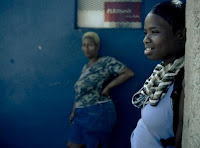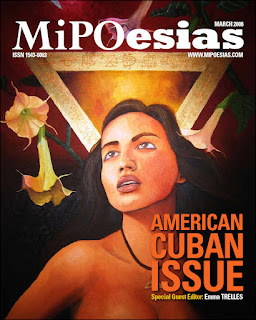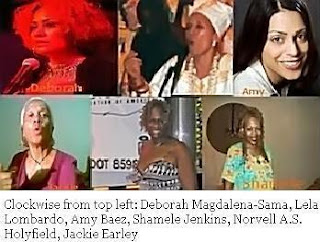 "Art for art's sake,"
"Art for art's sake," a popular bohemian creed during the early nineteenth century was a response to Romanticism and the idea, fostered from the inception of the Counter-Reformation, that art
should have an ethical or didactic purpose. It was an absolute aesthetic that viewed art as an end in itself and that it should not be subservient to any other goal (ethical, political, theological, or philosophical) but itself. It is also interesting that Dadaism (BTW, one of the many puns in my "reggae novel,"
Benjamin, my son is the fact that Benjamin (my Stephen Daedalus) calls his father, "Dada") had similar aims and became a part of the movement we now call Modernism, which represented a radical break with the past and rejected the "traditional."
These movements were reactions to historical events and their influence was exacerbated by the first European holocaust of World War I. Many of the artists who recoiled in horror when they saw how the power of art had been used for propaganda (religious or otherwise) created an aesthetic that would be immune to religious, political, or commercial agendas. In the case of James Joyce ("History is the nightmare from which I am trying to awake"), his solution was a literature that was grounded in myth, and used the city of Dublin as the point of trajectory. In A Portrait of the Artist as a Young Man, Stephen Daedalus tries to escape the "nets" (church, family, politics) of Ireland, and in the fourth chapter of Portrait, he lectures his friend, Cranly, about propaganda, pity, and terror and states that in discerning a work of art, "The mind is arrested and raised above desire and loathing."
"Art for art's sake" did not appear sui generis. It was a reaction to historical events in Europe, and while I agree with its aims to a certain extent (more anon), it cannot nor should it be applied to works of art that evolve out of a different historical experience. You lose many valuable understandings when you try to evaluate work using a measurement that is outside the intent of its creator. (As you may also discern, my bias is towards what was called the "New Criticism" and not "Deconstructionism" or "Deforestation" as George Lamming called it.)
This is why I've argued that
Brother Man by Roger Mais cannot be divorced from its historical/cultural context precisely because
Brother Man was the beginning of a new aesthetic-- what the poet/critic
Kwame Dawes dubbed the "
reggae aesthetic.”
It must have been exciting for Roger Mais to write Brother Man because he was witnessing the birth of Rastafari and its movement from the ghetto into middle class homes of Jamaica, and especially since Rastafari represented a radical break with the past, and restored the centrality of Africa to the imagination of Africans in the diaspora.
To put it another way. Imagine Da Vinci's
Vitruvian Man. Now imagine an African or the Rastaman, as the focus of the drawing into which the individual, community, and the divine become One:
InI--a vision of oneness at the centre of everything. If you can imagine that without smiling, without thinking of such a portrait as a parody or as humorous, you have entered the world of Rastafari. The irony is. however, that to describe this to non-Rastafari, I have to use similarities---whereas for Rastafari, the African was the first.
Rastafari created a freedom from all the other identities such as "postcolonial" with which
Derek Walcott struggled. For whereas postcolonial writers struggled with issues of "I am not,"Rastafari began from the position of "I am." Rastafari also obliterated the dichotomy of "black=body and white=mind," and all other Cartesian divisions. For Rastafari, InI became the measure of humanity. This was the epiphany of the mystic revelation of Rastafari and was the universe that Mais was trying to create in his work. Yet he had to rely on similarities to tell the story of Rastafari as he understood it.
Brother Man and
Children of Sisyphus began the process of creating a new aesthetic in
Jamaica, in which writers like myself, who grew up in the seventies, have been trying to extend. As you can also tell, I have followed Joyce's mythological approach. However, unlike Joyce who favored Greek mythology, I have used Yoruba mythology in
Benjamin, my son and my latest novel,
Virtual Yardies, is based on the Joycean premise of the "nail paring God of creation."
But what are the other implications for "writers of color"? Does "blackness" or "African-ness" become the only measure? That would be as tedious as the current state of publishing where only stories from
New York,
London, or
Paris are "privileged."
As a writer who grew up reading the fiction of
Mais,
Lamming, and
Patterson and the poetry of
Walcott,
Brathwaite, and
Scott along with the music of
Bob Marley, my commitment has always been (this is where I agree with "art for art's sake") first to the work itself or as Ernest Hemingway said, "[To] write a true sentence." To this I would add, "And make it interesting."
For no matter how politically charged or how socially redeeming a novel is, as a reader, I don't want to be bored to death. Art should never be viewed like medicine, "Take it. It's good for you." My view is similar to Duke Ellington's: "It don't mean a thing if it ain't got that swing."
That said, following the implications of the "reggae aesthetic," I do believe that art should incorporate social, historical and philosophical concerns (everywhere you look in the world, people of color still allow themselves to be oppressed)
and be interesting. To illustrate, a philosopher during an interview about my short story,
"I Want to Disturb my Neighbor": (adapted from Bob Marley's "Bad Card"), once asked me: "Should we disturb our neighbors?" To which I said, "Yes! Especially when you have to tell them, 'Hey, you're standing on my neck!'"
But the "message" should never be subverted to the demands of the story. A work of fiction, as John Gardner writes, "creates a vivid and continuous dream in the reader's mind."
So, even a cursory reading of my short stories that on the surface appear to be entertaining (e.g.
Uncle Obadiah and the Alien) reveals that the stories cover the plight of fatherless boys and their relationship with their mothers, child abuse, Yoruba cosmogony, Rastafari theology and a deep concern for the
sufferahs. As a sidenote, Bob does the same in "Johnny Was" (mother-son relationship); the
Yoruba look out call at the beginning of Natty
Dread and the auditory experience of Rastafari and the plight of the
sufferahs throughout his entire discography--and all the time, InI was still, "Jammin'"
Bob was committed to freedom, but he wrote in a very specific musical idiom: reggae. Yet, he also borrowed musical ideas from the Beatles, Bob Dylan, and James Brown. He did not live in a musical ghetto, but listened to a wide variety of music. And given the omnivorous voracity of reggae to adapt to a variety of musical styles, while Bob was living in self-imposed exile in England, he wrote "Punky Reggae Party"--his reaction to the Punk movement.
The "reggae aesthetic," of which Brother Man is a cornerstone, is the attempt of my generation to speak in our own voice, and it is similar to artists in the "art for art's sake" movement who sought an idiom--and not those of their elders--to describe new realities. The very wise Frantz Fanon's wrote: "Each generation out of relative obscurity must discover their destiny and either fulfill it or betray it.” If this means to "rebel against society's expectations, then so be it. All I know, it that we must speak in our own tongues using our own breath.
James Joyce found his way in mythology, and Gabriel Garcia Marquez found it in the indigenous worldview of Colombia and created "magical realism." The interesting link between these two writers is that they listened to other writers, critics, artists and created their own timbre, pitch--voice. And these works achieve "universality" because of their specificity. Ulysses and Finnegan's Wake could only take place in Dublin, yet a fiction created in August Town, Jamaica would be labeled as "provincial."
Beauty, wisdom, and joy surround us and as artists--the central nervous system of a people, place, and time--it is our duty to hear, see, smell, taste, feel, and transform--as only we can--these experiences in our imaginations into words, paint, and song. Or as Ezra Pound said, "Make it new."
***

















